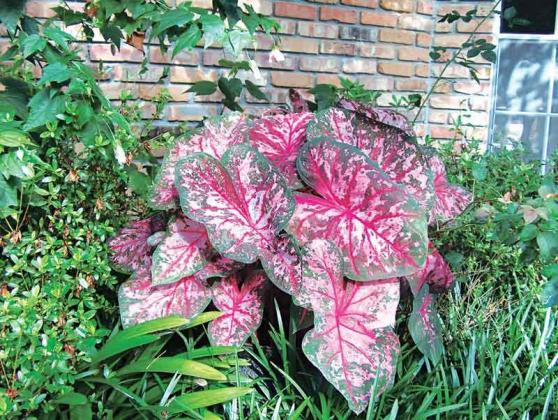
Heather Kirk-Ballard /LSU AgCenter horticulturist
Its fall, and we’ve already had our harvest moon.
Fall provides cooler weather, so we can get back out into the gardens, lawns and landscapes comfortably. Fall marks harvesttime for many crops, such as pumpkins and other squash, persimmons, tangerines, Asian pears, apples and, of course, satsumas.
One other thing you should be harvesting this time of year is your caladium bulbs for planting again next year. Caladiums are a favorite in the South and all across the U.S. They are especially loved for their large, heart-shaped or strap-shaped leaves that come in amazing color combinations of green, pink, white and red. Native to South America, they thrive in our hot and humid climate here in Louisiana. You have thousands of cultivars to choose from.
One major feature of this plant that sticks out in my mind is color for shaded areas. Most of us know the struggle of finding anything of significant color that does well in shade. Most flowering plants require a great deal of sun for blooms, and most foliage plants thrive in shade. So it is difficult to find a suitable plant of color for shade. Struggle no more — caladium is your plant. With little to no pest or disease issues, it is easy to care for and looks good from spring to early fall each year.
Caladiums, in general, prefer partial sun but also thrive in full shade. Some new varieties or the fancy strap-leafed caladiums can tolerate more sun and, under the right cultural conditions, can tolerate full sun. Tubers perform best in well-drained soil with partial sun. Areas that hold water lead to tuber and root rot.
The beautiful foliage of caladiums makes a spectacular show when they are planted in large groupings around shrubs and trees, as landscape bed borders and in containers. Every plant nursery carries a large selection each spring.
Often referred to as bulbs, caladiums are truly tubers, botanically speaking. They come in different size grades much like the edible potato tubers sold in grocery stores and farmers markets. The largest ones, called mammoth, are 3 1/2 to 4 1/2 inches. Jumbo tubers are 2 1/2 to 3 1/2 inches, and No. 1s are 1 1/2 to 2 1/2 inches. No. 2s and 3s are smaller.
The larger the tuber, the more “eyes,” or growth points, they have. These tubers will grow into larger, fuller plants. We consume potato tubers for their carbohydrate energy source. Just as potato tubers provide us energy when we eat them, caladium tubers provide energy stores for tubers to go into winter dormancy and grow again in spring as the days lengthen and the soil temperatures rise in the right hardiness zones.
In USDA hardiness zones 9 to 11, which include most southern parishes here in Louisiana, tubers can be left in the ground all year round. Help protect them from extended freezing temperatures with a thick layer of mulch. For those parishes that fall into zone 8 and below, tubers are grown as annuals planted each spring as the soils warm.
October marks the beginning of the end for caladium glory days each year. As the days shorten and the nights cool, caladium plants go into winter dormancy. Now is the time to decide whether to let them go and replant new tubers next year or to dig them up, dry them, store them and plant them again next spring.
Here are some tips on how to dig up and preserve caladium bulbs in zones that do not stay warm enough, namely north Louisiana parishes. First, start with the best material. If your tubers were in optimal conditions — evenly moist, well-drained soil and partial sun as opposed to full shade — you should be able to expect decent sized bulbs that will have enough energy reserves to carry them over until next year.
Dig caladium tubers up when the majority of leaves have turned yellow and are falling over. Use a garden fork to lift them from the soil gently. Keep leaves attached, remove soil and wipe clean with a soft brush or cloth. Let the leaves dry for two weeks until they have become completely dry and turned brown. You can then pull the dried leaves from the tuber.
Store clean, dried tubers spaced apart from one another in a cool place in a paper bag, cardboard box or other breathable material. Do not use plastic bags or other airtight storage that traps moisture.
A warm garage, pantry or storage closet with ambient temperatures are good choices. Give them room for air movement. If you have a hard time telling what side is up or down on the tuber, mark the tops with a permanent marker before storing.
Voila. You are prepared for next spring with no need to shop if you’ve properly preserved your tubers.
Plant caladiums in the spring when the soil warms to at least 65 degrees and days begin to warm. This is typically April in Louisiana. If you want to give your plants a head start, plant them indoors in late February or early March in a warm, sunny window.
In the landscape, plant tubers smooth side down at around 2 1/2 to 3 inches deep and 6 inches apart. Caladiums also do well in containers on shaded porches, patios and decks to decorate your outdoor sitting areas with a little pop of color.
Use the strap-leaf caladiums in sunny areas such as window boxes and hanging baskets. They, of course, make a striking display as a border in landscape beds and to line walkways.
Do you want a fuller, bushier plant? You can stimulate this by carefully removing a few of the more prominent eyes before planting, being careful not to damage surrounding tissue or smaller buds.
Check the LSU AgCenter website for recommended trial varieties at http://bit.ly/lsucaladiums.
